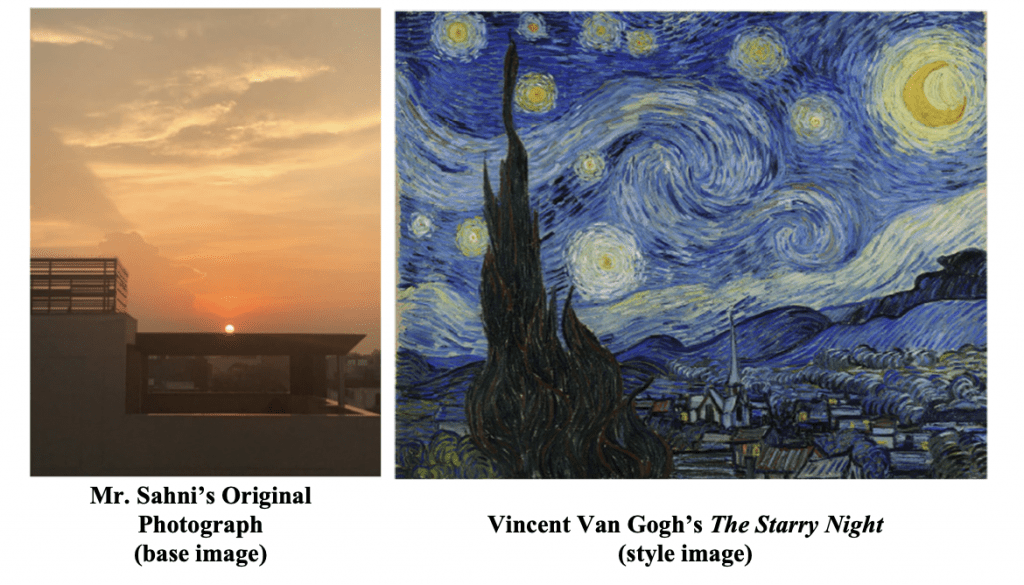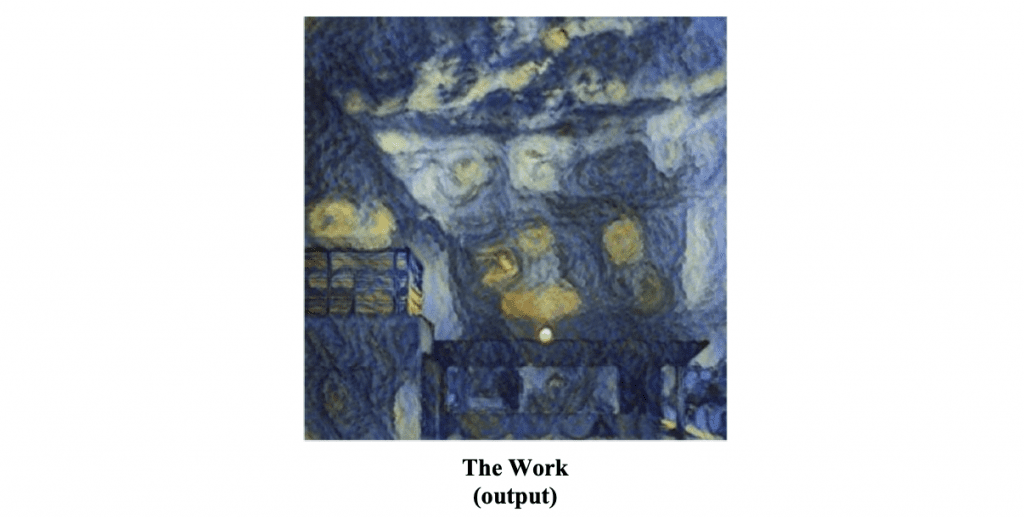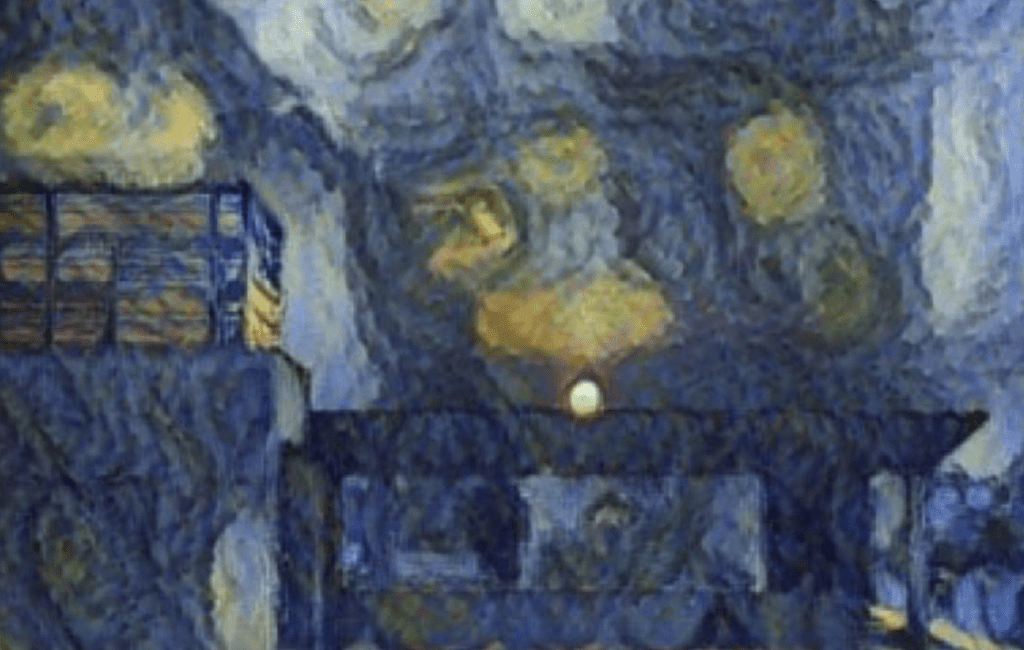The U.S. Copyright Office has issued its latest determination on the protectability of artificial intelligence (“AI”)-generated artworks. In a letter on Monday, the Copyright Office’s Review Board alerted counsel for Ankit Sahni that it has considered his second request for reconsideration of the Office’s refusal to register a two-dimensional artwork claim in a work, titled “SURYAST,” and has affirmed a previous denial of registration, marking the latest instance in which the Copyright Office has refused to register a work that was created using an AI-powered image generator platform.
Some background: The matter got its start in December 2021 when Sahni filed an application to register the SURYAST work, listing two authors in his application: himself as the author of “photograph, 2-D artwork” and the “RAGHAV AI Painting App” as the author of “2-D artwork.” Sahni identified himself as the sole copyright claimant. In response to a request for additional information, Sahni told the Copyright Office that he created the work by using RAGHAV, which “generat[es] an image with the same ‘content’ as a base image” – Sahni used an original photo that he took – but “with the ‘style’ of [a] chosen picture” (van Gogh’s Starry Night in this case). RAGHAV users can dictate the level of stylization of the new photo by selecting a numerical value in RAGHAV.

The Office primarily refused to register the work on the basis that it “lacks the human authorship necessary to support a copyright claim.” Specifically, the Office stated that despite Sahni’s claim that the work includes some human creative input, the work is not registrable, as “this human authorship cannot be distinguished or separated from the final work produced by the computer program.”
Following an initial request for reconsideration, in which Sahni argued that “the human authorship requirement does not and cannot mean a work must be created entirely by a human author,” the Copyright Office again concluded that the work could not be registered, as it “is a derivative work that does not contain enough original human authorship to support a registration.” The Office found that “the new aspects of the [SURYAST] work were generated by ‘the RAGHAV app, and not Mr. Sahni – or any other human author,'” making it so that the “derivative authorship was not the result of human creativity or authorship” and therefore, not registrable.
In a second request for reconsideration, Sahni argued that: (1) RAGHAV is merely an “assistive software tool,” subject to his creative decisions (namely, his selection of the original photo, the Starry Night image, and level of stylization); (2) he “provided the traditional elements of authorship for both the original photo and the [SURYAST] work” by taking the original photo and “direct[ing] the RAGHAV tool to make changes to the colors, shapes, and style in a particular manner,” thereby, giving himself “control of the work and resulted in the work containing [various] elements;” and (3) SURYAST is not a derivative work because it is not “substantially similar” to the original photo.
No Copyright when AI is the Creator
After some additional back and forth with Mr. Sahni, the Copyright Office’s Review Board held on December 11 that SURYAST “does not contain sufficient human authorship necessary to sustain a claim to copyright.” Setting the stage in its decision, the Board stated that “when analyzing AI-generated material, [it] must determine when a human user can be considered the ‘creator’ of AI-generated output.” Citing the Office’s March 2023 guidance on AI generated works, the Board asserted that “in considering an application for registration, the Office will ask: Whether the ‘work’ is basically one of human authorship, with the computer [or other device] merely being an assisting instrument, or whether the traditional elements of authorship in the work (literary, artistic, or musical expression or elements of selection, arrangement, etc.) were actually conceived and executed not by man but by a machine.”
In order for the Copyright Office to enable it to conduct such an analysis, registration applications must disclose “AI-generated content that is ‘more than de minimis,’” noting that “if all of a work’s ‘traditional elements of authorship’ are generated by AI, the work lacks human authorship, and the Office will not register it.” On the other hand, “if … a work containing AI-generated material also contains sufficient human authorship to support a claim to copyright, then the Office will register the human’s contributions.”

With that in mind and given that Sahni’s original photograph is “a separate work of authorship because it was fixed separately from the work,” the latter of which contains AI-generated material, the Board found that “the expressive elements of pictorial authorship” were not provided by Mr. Sahni. “As Mr. Sahni admits, he provided three inputs to RAGHAV: a base image, a style image, and a ‘variable value determining the amount of style transfer.’” Because Sahni only provided these three inputs to RAHGAV, “the RAGHAV app, not Mr. Sahni, was responsible for determining how to interpolate the base and style images in accordance with the style transfer value,” according to the Board.
In particular, the Board held that “the fact that the work contains sunset, clouds, and a building are the result of using an AI tool that “generate[s] an image with the same ‘content’ as a base image, but with the ‘style’ of [a] chosen picture.’ But Mr. Sahni did not control where those elements would be placed, whether they would appear in the output, and what colors would be applied to them – RAGHAV did.”
The Board was similarly not convinced by Sahni’s description of RAGHAV as “an assistive tool” that works similarly to “a camera, digital tablet, or a photo-editing software program.” This description “inaccurately minimizes RAGHAV’s role in the creation of the work and conflicts with other information in the record,” the Board asserted, noting that “RAGHAV’s interpretation of Mr. Sahni’s photograph in the style of another painting is a function of how the model works and the images on which it was trained on—not specific contributions or instructions received from Mr. Sahni.”
While Sahni selected the numerical variable for the “strength” of the style, “that choice alone is insufficient to warrant copyright protection, [as] a single number for a style filter is the kind of de minimis authorship not protected by copyright,” the Board stated, citing Feist.
The Board also did away with Sahni’s remaining arguments, finding that his “specific choices of image inputs and filter strength … from nearly infinite permutations and possibilities of specific inputs,” still only constitute “an unprotectable idea for the work, that is: an altered version of his photograph in the style of The Starry Night.” At the same time, the Board shot down Sahni’s argument that his original photograph was “not a preexisting work.”
The Bigger Picture
The AI-specific rejection from the Copyright Board follows from a number of other registration refusals, including one in which the Office refused to register an image that Stephen Thaler represented to the Copyright Office as being created without any human involvement. Judge Beryl A. Howell of the U.S. District Court for the District of Columbia agreed with the Copyright Office’s decision, stating this fall that “copyright has never stretched so far as to protect works generated by new forms of technology operating absent any guiding human hand, as plaintiff urges here.” Thaler has since appealed the district court’s decision.
Before that, the Copyright Office walked back on a registration for Kristina Kashtanova, who used AI image-generator Midjourney to create images for a graphic novel, something that she did not initially disclose in her copyright application. After issuing a registration to Kashtanova for the “Zarya of the Dawn” graphic novel, the Office decided early this year that while she “is the author of the work’s text, as well as the selection, coordination, and arrangement of the work’s written and visual elements [and] that authorship is protected by copyright,” the images that were generated by the Midjourney technology “are not the product of human authorship,” and thus, not protected.











